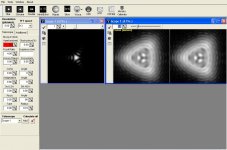I recently suggested, in another thread, trying binocular on bright stars as a rough test of optical quality. To try to go beyond this can get pretty complicated.
I have some experience with astronomical telescopes, but really very little at critically testing binoculars. Binoculars do not stand up well to boosted tests on point sources. Their aberrations are a messy zoo, difficult to interpret. I hope Henry Link, Surveyor, and some of the bona fide binocular experts will jump in here and help. I can share a little something useful, and I'll try.
At 3x boost, there will still be features that are resolved by the binocular optics, but appear so small, that they depend on you having exceptional visual acuity to see. Unless you are 20/10-correctable, like some lucky guys are, 8x or 10x boost would be nice.
I doubt that a normal eye could see the in focus first diffraction ring at 3x boost. 40-50x per inch of aperture is usually needed for a decent view of this feature. Also, I believe that it is very unusual for a binocular optic to be of the near perfection necessary to produce a neat textbook-like diffraction pattern in the first place. That requires nearly perfect optics, which just isn't necessary at bino powers, and would be very difficult with the complex prisms. Binocular opticians aren't foolish enough to over engineer at huge expense, for little improvement. That kind of near-perfection is the territory of astronomical telescopes, which are optically simpler than binoculars, and routinely required to operate at up to 50x per inch of aperture.
So the circular ring you are seeing puzzles me. There is of course a chance that your eyes are that exceptional, and also that your binocular is exceptional too, and you really are seeing the "first diffraction ring". For now, let us hope.
I would suggest higher boost power, and testing both barrels.
Regarding the horizontal green line seen when out of focus, I don't know, but it isn't normal. Streaks on bright point sources can result from a roof prism not having a good knife edge cut to the roof apex, but the streak is not colored any differently form the point source itself, and is best seen when in focus. A smattering of this is very common and mostly benign as far as daytime usage. What you describe is different. Still, I'm guessing, only guessing, it's due to some kind of prism effect/defect.
Ron




